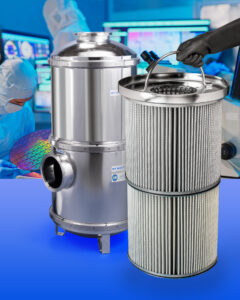
Vacuum Pump Inlet Trap For Heavy Contaminant Vacuum Processes
A high-capacity vacuum pump inlet trap designed to remove high quantities of contaminants from LPCVD, PECVD, MOCVD, HVPE, ALD and similar processes has been introduced
A typical application for a multiple-stage vacuum pump trap is a reactor that deposits silicon nitride (Si3N4) onto silicon wafers in an LPCVD (low pressure chemical vapor deposition) process. The deposition of silicon nitride from the thermal reaction of dichlorosilane (SiH2Cl2) and ammonia (NH3) creates large amounts of solid matter in the exhaust line, which, if not taken care of, cause significant downtime. The solid effluent from an LPCVD silicon nitride process consists of ammonium chloride (NH4Cl), silicon nitride, and silicon dioxide (SiO2). The ammonium chloride is the most difficult constituent to deal with, since it condenses outside the hot reactor on the cooler surfaces of active components such as the isolation valve and the pressure control valve, as well as in the active areas of the pump. Ammonium chloride build-up causes frequent pump failures – as often as once every two months. The problems caused by the effluent from this process appear to be universal, with failures occurring in all types of reactors, from various manufacturers, and with both wet and dry pumps.
The dry pump on one reactor running silicon nitride failed, on average, every two months. This process deposits a 750 nm film over the course of five hours. The user performed routine maintenance every 50 runs, or after every 37,500 nm of deposition. To reduce the maintenance and the catastrophic pump failures, the user installed a threestage trap, consisting of a knock-down stage, a water cooling stage, and a filtration stage consisting of long stainless steel mesh filter elements (Figure 2). The trap proved to be efficient, allowing the time between routine maintenance to be doubled to 100 runs, or every 75,000 nm. The trap has successfully protected the dry pump from failure for well over one year.
Figure 2. A multi-stage trap in the foreline of an LPCVD system protects from catastrophic pump failure.
Upon disassembly of the trap during routine maintenance, the user found heavy accumulations of ammonium chloride in the knock-down and water cooling stages. Apparently, the ammonium chloride remained in vapor phase until reaching the sharp pressure drop provided by the knock-down stage. Additional ammonium chloride condensed out in the water cooling stage as the exhaust vapor cooled. A fine dust deposited on the stainless steel gauze elements, probably silicon nitride particulates.

A high-capacity vacuum pump inlet trap designed to remove high quantities of contaminants from LPCVD, PECVD, MOCVD, HVPE, ALD and similar processes has been introduced

A line of robust vacuum pump exhaust traps for use with dry scroll pumps to remove carbon soot which can damage recirculation systems has been introduced

Cleaning up an LPCVD Silicon Nitride Deposition System A typical application for a multiple-stage vacuum pump trap is a reactor that deposits silicon nitride (Si3N4)

Throughput Increases in Silicon Dioxide Deposition Systems Another common application for a multiple-stage vacuum pump trap is a CVD (chemical vapor deposition) process to deposit

Multi-Stage Traps Clean Up Vacuum Systems Cleaning up an LPCVD Silicon Nitride Deposition System A typical application for a multiple-stage vacuum pump trap is a

Multi-Stage Traps Clean Up Vacuum By Herbert W. Gatti and Lise C.H. Laurin The costs involved in maintaining vacuum processes in a manufacturing facility can
247 Rangeway Road
PO Box 359
North Billerica, MA 01862-0359
P: 978 667 2393
F: 978 671 0014
Email: sales@massvac.com
© 2024 MassVac Inc.
Webdesign by Turek Design